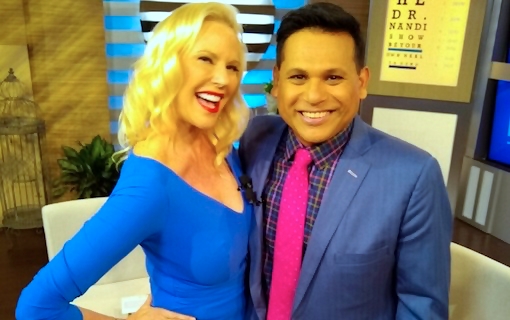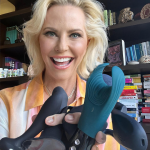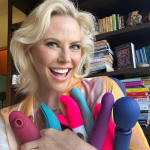Namaste means, “I honor the light within you.” It’s an Indian term that my friend, Dr. Partha Nandi uses on his show, The Dr. Nandi Show.
Tim and I just got back last night from Michigan where we flew to film a segment for this upcoming season of the show.
I’ve received hundreds of emails with the most heart-wrenching stories about sexual vitality —any emotional or physical issues that are holding you back from having the intimacy you desire. Thank you to all who shared their deeply personal struggles. It helps me be a better support to everyone.
I want to help “fix” everyone’s struggles. And as I meditated on how I might help as many as possible I realized that the segment I created for the Dr. Nandi Show was the most beneficial advice I could provide to you.
The 4 Steps To Resolve Embarrassing, Painful, Emotionally and Physically-Challenging Intimacy Issues with the TO-DO Framework.
Midlife can take its toll on our intimacy.
Whether lovemaking has become painful, or you’re dealing with erectile issues, lack of libido, sensation loss, chronic health problems or body image issues, you don’t have to give up your pleasure and connection just because you’re aging.
There are two big obstacles to bringing back that loving feeling. The first is becoming aware that new regenerative techniques can turn back the clock to give couples the feeling of being young again. The other is talking to your partner about what’s not working because of fear, shame or embarrassment.
The number one factor to longevity is having a happy relationship.
According to the Harvard Study of Adult Development, one that spans nearly 80 years, finds that “how happy we are in our relationships has a powerful influence on our health, says Robert Waldinger, director of the study, a psychiatrist at Massachusetts General Hospital and a professor of psychiatry at Harvard Medical School. “Taking care of your body is important, but tending to your relationships is a form of self-care too. That, I think, is the revelation.”
Sex, Money, and Kids are the top three things couples fight about… Which is why a couple must remember two important things:
1) Your partner is your ally and
2) A relationship is a practice.
Here’s my four-step TO-DO Framework for resolving intimacy issues with your partner, even when it embarrasses you or makes you feel ashamed or guilty — all common feelings that come from the loss of sexual vitality that is a part of the aging process.
The TO-DO Framework helps you get to the source of your waning intimacy so you can work together to find solutions.
There are four steps to the TO-DO Framework.
1) Time — Set A Date To Bring The Issues To Light.
2) Obstacles — Where Are We Now And What’s In The Way?
3) Determine — Where Would We Like To Be?
4) Overcome — What Do We Do About It?
Let’s take them step-by-step:
1) Time — Set A Date To Bring The Issues To Light.
There’s no getting around communication. It’s the bedrock of a good relationship. But most couples find sexuality the hardest issue to discuss. By the time you hit middle age, life begins to get real. Your problems won’t go away or become any easier if you wait. Sexual health problems are best nipped in the bud. You have to accept that these problems won’t go away unless you get on the same page to find solutions.
When you discuss your sex life, it’s important to reassure each other. A highly-functioning couple uses reassurance as a prime tool in their communication toolbox.
It’s important to set a date and location where you won’t be interrupted, and you’ll have plenty of time to unearth all of your worries and concerns. Rushing creates stress. Stress shuts down your resources. If you mention an issue the cuff, it could create upset for you or your partner.
Sitting on the sofa, holding each other’s hands can be very comforting. Leaving a lot of space for more feelings to arise and get put on the table helps you find solutions more easily. Planning in advance so you’re well fed and hydrated, in a calm mood and focused on supporting each other will make the discussion less confronting and open up more possible solutions.
When you’re together the first place to start is with a level set and tender hearts…
2) Obstacles — Where Are We Now And What’s In The Way?
Each of you can take turns sharing your perspective about what’s happening in your intimate life. Explain how age is affecting you. You want to share what’s changed. Explain what’s changed for you and how that affects you. Share what you miss about the way things used to be. Be as specific as possible using examples of what you liked about the way things used to be and how they are for you now.
Use “I Statements,” instead of “You statements.”
Instead of, “Since you went through menopause you reject me every time I try to get intimate,” you’d say, “I feel alone and rejected since right around the time when you went through menopause.”
“It makes me crazy to have to shout at you all the time. It’s like we’re constantly fighting because you can’t hear me,” turns into, “I’d like to schedule an appointment for you at the audiologist to see how we can improve your hearing so I don’t have to shout at you all the time.”
“You don’t even look at me anymore,” becomes, “I’d like to explore hair restoration because I’m feeling very unattractive and old looking. The story I’m telling myself is that I’m less appealing to you now that I’m going bald.”
In addition to what’s changed and what you miss, also include all of your fears. You can go back and forth taking turns finishing this sentence:
I’m afraid ___________.
I’m afraid you don’t find me attractive anymore.
I’m afraid that because intercourse is painful you’re never going to want to be intimate again.
I’m afraid that because you’ve gone through cancer I’ll never have sex again and I’ll be stuck in a sexless marriage.
I’m afraid that you’re avoiding me because you have ED.
I’m afraid that you’re going to divorce me and marry a younger woman.
When you open yourself vulnerably, this gives your partner a chance to reassure you.
What you’ll find is that their concerns are often far from your own reality and experience.
And in those places where the problem is painful sex, erectile dysfunction, lack of libido, hearing loss, or hair loss, there are many things you can do to fix the issue.
The process of uncovering the obstacles and surfacing those that are actually an issue, not an imagined fear gets you to the next step.
Make a list of what the root problems are to set yourself up for the next step.
3) Determine — Where Would We Like To Be?
Often in midlife, you’re not trying to be 30 again. You don’t need to reverse mid-life aging to how it was in your youth. You just need to do some simple remediation.
Instead of hoping for a daily delight, you might be fine with a once-a-week lovemaking date. This is the time when you share what it is you want now in your intimate life.
Do you want to be held more? Are you looking for more affection? Do you want to experience something that you’ve never tried and cross it off your bucket list?
Get all your desires down and begin to figure out what just needs to go on the list of fun things you want to do versus the list called, “Research Solutions.”
4) Overcome — What Do We Do About It?
Your list might end up looking like this:
Research the best ways to reverse ED.
Get a consultation for Bio-Identical Hormone Replacement.
Look into Red Light Therapy for Skin Tone and Hair Loss.
Buy some organic coconut and sweet almond oil.
Schedule date night once per week.
Learn a new bedroom skill together.
Then you divide and conquer. Who will do the research? Who makes the appointments? What is your budget?
Check in on your progress at resolving your issues at the first of every month. Have a date to sit down and go over how you’re feeling and what still needs work. Celebrate your progress. Thank each other for being great communicators that can accomplish important tasks together.
To recap, the TO-DO Framework steps are:
1) Time — Set A Date To Bring The Issues To Light.
2) Obstacles — Where Are We Now And What’s In The Way?
3) Determine — Where Would We Like To Be?
4) Overcome — What Do We Do About It?
You can use this framework for all kinds of issues that come up not just in your love life, but throughout your life. Thanks to my friend and mentor, Dr. Susan Campbell for helping me organize this formula! I can’t support you at this level of smarts without my mentors.






